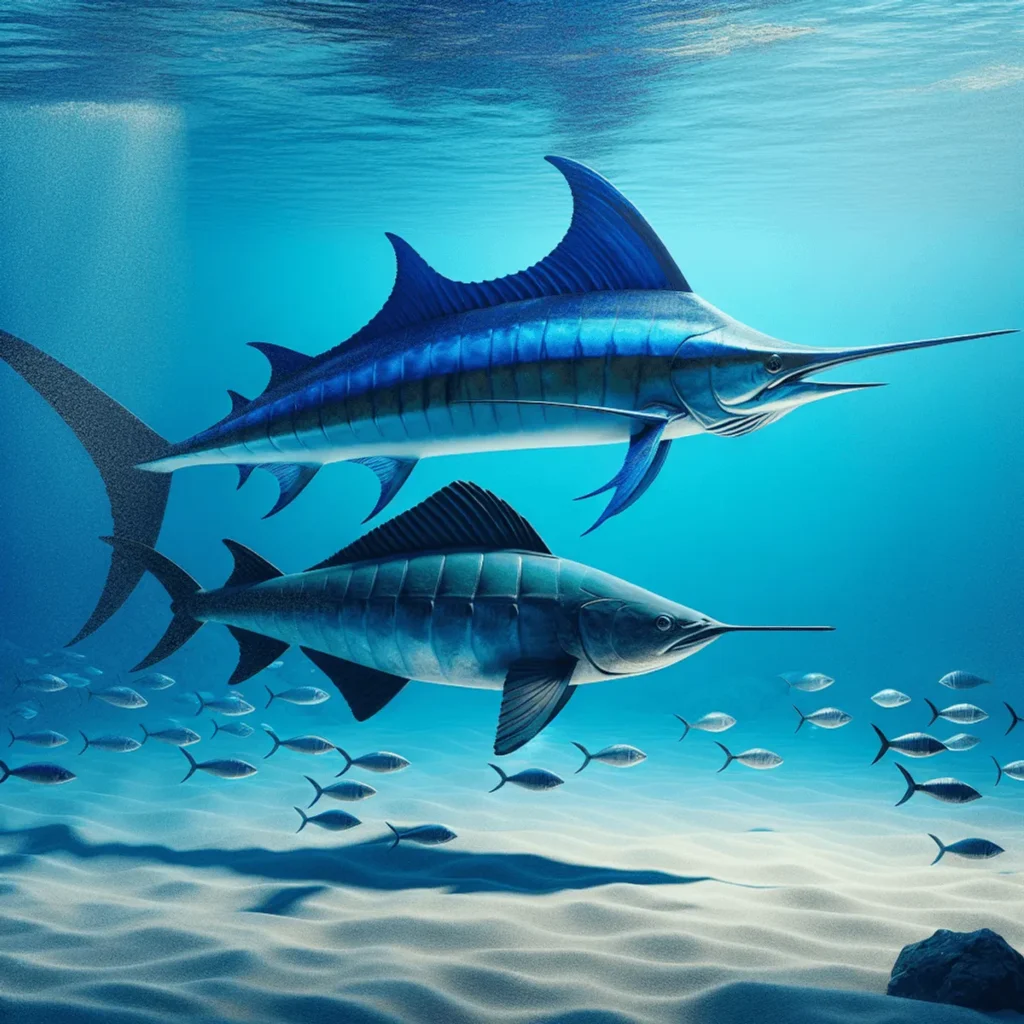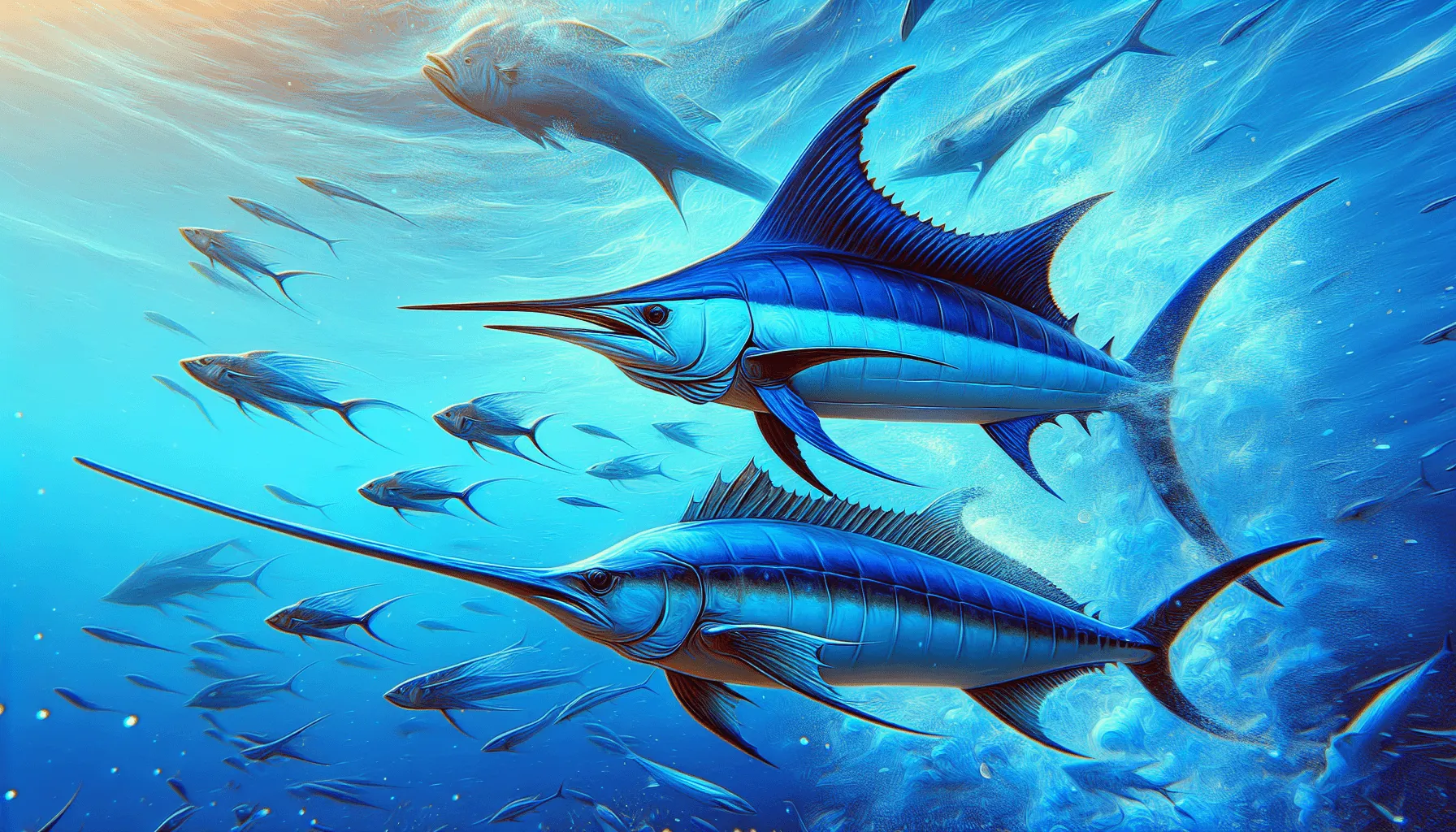Marlin and swordfish are two of the ocean’s most formidable apex predators, often at the center of the marlin vs swordfish debate. Both belong to the billfish category but come from different taxonomic families.
Understanding these species reveals their significant roles in marine ecosystems and their value in culinary and sport fishing arenas:
- Culinary Value: Marlin’s rich flavor contrasts with swordfish’s milder taste.
- Sport Fishing: Their size and strength make them prized targets.
Marlin and swordfish are both fascinating billfish with distinct differences that set them apart from each other.
Physical Characteristics
Understanding the physical characteristics of marlin and swordfish offers insight into their unique adaptations as apex predators in the billfish family.
Marlin
Body Shape and Coloration
Marlins, particularly the blue marlin, have an elongated body with vibrant blue or striped patterns. These striking colors are not just for show; they play a role in camouflage and signaling during hunts. The identification of marlins can often be linked to these distinctive colorations.
Bill
The marlin’s bill is long and rounded, designed to slash through schools of fish with precision.
Dorsal Fin
The dorsal fin of a marlin is high and crescent-shaped, extending towards the tail base. This fin structure aids in their agility and speed, making them formidable hunters.
Swordfish
Body Shape and Coloration
Swordfish have a more rounded body shape compared to marlins. Their coloration is generally a darker brownish-black on top, fading to lighter shades underneath.
Bill
True to their name, swordfish possess a flat, elongated bill that resembles a sword. This adaptation is perfect for stunning prey.
Dorsal Fin
The dorsal fin of a swordfish is triangular and less pronounced than that of the marlin. Despite being less visually striking, it contributes to their streamlined shape, allowing efficient swimming at various depths.
Comparison
- Bills: Marlins have rounded bills for slashing, while swordfish have flat, sword-like bills for stabbing.
- Dorsal Fins: Marlins feature high crescent-shaped dorsal fins, contrasting with the triangular dorsal fins of swordfish.
These physical differences highlight how each species has evolved unique features suited to their specific hunting strategies and environments. For instance, the swordfish is renowned for its unique adaptations which make it a fascinating subject of study. Additionally, the North Atlantic swordfish showcases some remarkable traits that further emphasize the diversity within this species.
Size Comparison

When comparing the size of blue marlin with that of a swordfish, notable differences can be observed:
- Blue Marlin: Typically grows up to 16.4 feet in length and can weigh as much as 1,400 pounds.
- Swordfish: Generally reaches lengths of about 14 feet and can weigh up to 1,165 pounds.
The blue marlin tends to be stockier in comparison to the swordfish, adding to its robust appearance. This substantial difference in body structure aids in the identification of these species, especially when analyzing images of marlin and swordfish.
Habitat Preferences
Marlins thrive in tropical and subtropical waters, often favoring shallower areas near the surface. These top predators are mainly found in the Atlantic, Pacific, and Indian Oceans. They prefer warmer waters because of their active lifestyle, which makes them popular among sport fishermen in these areas.
Swordfish, on the other hand, live in a wider range of ocean environments. They can be found in both warm open oceans and colder depths, capable of moving up and down vertically. During the day, swordfish dive to depths up to 2,000 feet where temperatures are much cooler. At night, they come up to shallower waters closer to the surface. This unique behavior pattern means that fishing methods for billfish like swordfish are quite different from those used for marlins.
Both species’ habitats reflect their adaptations and hunting strategies:
- Marlins’ habitat allows them to take advantage of schooling fish near the surface.
- Swordfish’s habitat lets them hunt prey at different ocean depths.
Understanding these habitat preferences is crucial for planning successful fishing trips. For instance, knowing the best times to catch these species can significantly improve your chances of a good haul. You can refer to this helpful fishing calendar for optimal fishing times based on seasonal patterns.
Behavioral Differences

Understanding the behavior of marlins and swordfish reveals fascinating contrasts.
Marlins
Marlins exhibit social behavior, often seen hunting in groups. This gregarious nature allows them to effectively target schools of fish such as tuna and mackerel. Their coordinated hunting strategy showcases their agility and speed, which can reach up to 80 mph.
- Social hunters
- Group hunting strategies
- High-speed chases (up to 80 mph)
Swordfish
On the other hand, swordfish are solitary hunters preferring a more independent approach. They are primarily nocturnal, engaging in most of their hunting activities under the cover of darkness. Swordfish utilize their distinctive bills to slash and stun prey like squid, making it easier to capture.
- Solitary hunters
- Nocturnal activity
- Prey disruption using bills
These behavioral differences highlight unique adaptations that each species employs for survival and efficiency in their respective environments.
Dietary Habits
Understanding the diet of marlins and swordfish provides insight into their unique hunting strategies and ecological roles.
Marlins’ Feeding Methods
Marlins primarily target schools of fish, such as:
- Tuna
- Mackerel
- Flying Fish
Their feeding technique involves using their long, rounded bills to slash through schools, stunning or injuring multiple fish at once. This aggressive strategy allows them to capture several prey items in a single strike.
Swordfish’s Hunting Technique
Swordfish, on the other hand, employ a different approach. Their diet includes:
- Squid
- Pelagic Fish
Using their flat, elongated bills, swordfish disrupt prey schools by making swift lateral movements. This disorienting method makes it easier for them to catch individual targets. Their preference for nighttime hunting also sets them apart from marlins, as they leverage the cover of darkness to ambush unsuspecting prey.
Both marlins and swordfish exhibit specialized feeding behaviors that highlight their adaptations as apex predators in the ocean ecosystem.
Reproductive Habits
Understanding the reproductive habits of marlins and swordfish reveals significant differences.
Marlins’ Reproductive Process
- External Fertilization: Marlins engage in external fertilization where females release thousands of eggs into the water column.
- Spawning Locations: This typically occurs in warm, tropical waters which provide optimal conditions for egg development.
- Lack of Parental Care: Post-spawning, marlin eggs are left to fend for themselves, with no parental involvement.
Swordfish’s Spawning Events
- Multiple Spawning Events: Swordfish differ by having multiple spawning events throughout the year.
- Egg Release: Females can release millions of eggs during these events, increasing chances of survival for the offspring.
- No Parental Care: Similar to marlins, swordfish do not exhibit any form of parental care post-spawning.
Both species ensure the continuation of their lineage through prolific egg production, yet their methods highlight distinct evolutionary strategies.
Culinary Uses
Marlin and swordfish offer distinct culinary experiences, each prized for their unique flavor profiles and cooking versatility.
Marlin
- Flavor Profile: Rich and robust, marlin has a denser flesh that is often compared to beef in texture.
- Popular Cooking Methods:
- Grilling: The marlin’s firm flesh holds up well on the grill, making it a favorite for BBQ enthusiasts.
- Broiling: This method helps retain the moisture and enhances the natural flavors of the fish.
Swordfish
- Flavor Profile: Milder with slightly sweet undertones, swordfish is noted for its tender and moist texture.
- Popular Cooking Methods:
- Grilling: Swordfish steaks are perfect for grilling, offering a succulent result with a smoky flavor.
- Broiling: Broiling brings out the subtle sweetness of the swordfish, resulting in a delicate yet flavorful dish.
When preparing dishes with either marlin or swordfish, both species provide versatile options that can cater to diverse culinary preferences.
Fishing Techniques
How to Catch Swordfish

Catching swordfish requires specific techniques due to their deep-water habitat and nocturnal nature. The most effective methods include:
- Deep-Dropping: Using electric or manual reels with heavy weights to reach depths of up to 2,000 feet. Baits like squid or mackerel are commonly used.
- Night Fishing: Targeting swordfish at night when they move to shallower waters. Lights are often used to attract these fish towards the boat.
Tips from Captains:
“Patience is key when deep-dropping for swordfish. Ensure your bait reaches the right depth and be prepared for a long fight.”
How to Catch Marlin

Marlin fishing typically involves trolling in tropical and subtropical waters. Key techniques include:
- Trolling: Using artificial lures or baitfish like bonito while moving the boat at speeds of 7-9 knots.
- Live Baiting: Presenting live bait such as tuna or mackerel near marlin hotspots like offshore reefs and drop-offs.
Tips from Captains:
“Keep an eye on the water surface for signs of marlin feeding. Their acrobatic jumps can indicate a good spot.”
Conclusion: Which Fish Reigns Supreme?
When you compare swordfish and marlin, each fish excels in distinct areas. Size tips in favor of the blue marlin, reaching up to 16.4 feet and 1,400 pounds. Strength shows marlins as agile swimmers and acrobats, while swordfish display burst speeds during hunts. Culinary value varies with marlin’s rich flavor versus swordfish’s milder taste. Fishing techniques highlight unique methods for both species, making them prized catches in sport fishing.
In the epic battle of marlin vs swordfish, the winner depends on your perspective—whether you value size, agility, flavor, or fishing challenge.
FAQs (Frequently Asked Questions)
What are the main differences between marlin and swordfish?
Marlin and swordfish are both apex predators in the ocean, but they have distinct differences. Marlins typically have a vibrant blue or striped body shape, while swordfish are recognized for their flat bill and rounder body shape with a triangular dorsal fin. Additionally, marlins often hunt in groups, whereas swordfish are more solitary and active at night.
What are the average sizes of blue marlin and swordfish?
The average size of a blue marlin can reach up to 14 feet long and weigh over 1,000 pounds, while swordfish generally average around 10 feet in length and can weigh up to 600 pounds. This highlights the stockiness of blue marlin compared to the more streamlined swordfish.
Where do marlins and swordfish prefer to live?
Marlins prefer tropical and subtropical waters, often found in shallower areas. In contrast, swordfish inhabit warmer open oceans and can be found at colder depths due to their vertical migration patterns.
How do the dietary habits of marlins differ from those of swordfish?
Marlins primarily target schools of fish like tuna and mackerel using their speed and agility. On the other hand, swordfish utilize their long bills to disrupt prey such as squid, making their hunting techniques quite different.
What are the reproductive habits of marlins compared to swordfish?
Marlins reproduce through external fertilization, where eggs are released into the water for fertilization by males. Swordfish, however, engage in multiple spawning events throughout their lives without parental care for the young.
What culinary uses do marlin and swordfish have?
Marlin is known for its rich flavor profile, making it ideal for grilling or broiling. Swordfish has a milder taste that is also suited for similar cooking methods. Both species are popular choices in seafood cuisine but offer different flavors that appeal to various palates.



